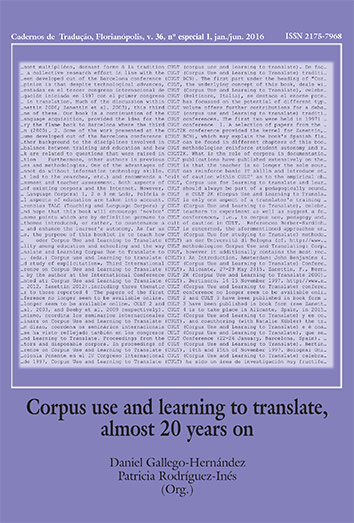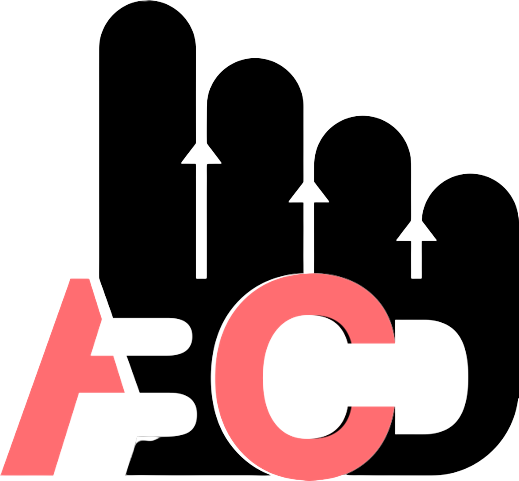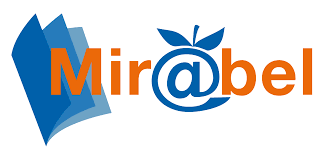Using corpora in scientific and technical translation training: resources to identify conventionality and promote creativity
DOI:
https://doi.org/10.5007/2175-7968.2016v36nesp1p88Resumo
Since the first Corpus Use and Learning to Translate (CULT) Conference in Bertinoro (Italy) in 1997, the usefulness of corpora for translators and trainee translators has been highlighted. From an initial approach where translators compiled ad hoc corpora in their hard drive for a subsequent study with lexical analysis software, there emerged a new trend towards the use of the Internet as corpus. In this second approach, the Web is perceived as a huge corpus which is accessed by means of online tools which produce monolingual wordlists and concordances from texts available from the Internet or pre-existing corpora, or by means of bilingual or multilingual concordancers displaying aligned texts from international institutions' parallel corpora. Bilingual concordancers and translation memories are widely used by translators and trainee translators because of the immediate translation solutions they offer, but these tools can restrain creativity by offering conventional solutions and eliminating layout and multimodal elements in texts. The aim of this article is to describe the exploitation of quality corpora in a scientific and technical translation course, focusing on texts on health translated from English into Spanish, and on terminological variation as a reflection of creativity in language.
Referências
Alarcon-Navío, E., López-Rodríguez, C.I. & Tercedor-Sánchez, M. “Variation dénominative et familiarité en tant que source d’incertitude en traduction médicale.” Meta 61.1 (2016).
Barlow, M. 2002. “ParaConc: Concordance software for multilingual parallel corpora.” Proceedings of the Third International Conference on Language Resources and Evaluation. Workshop on Language Resources in Translation Work and Research, 20-24.
Baroni, M., Bernardini, S., Ferraresi, A. & Zanchetta, E. “The WaCky Wide Web: A collection of very large linguistically processed Web-crawled corpora.” Journal of Language Resources and Evaluation 43.3 (2009): 209-226.
Bayer-Hohenwarter, G. Triangulating translational creativity scores. “A methodological study in translation process research.” In: C. Way, S. Vandepitte, R. Meylaerts & M. Bartłomiejczyk (eds.). Tracks and Treks in Translation Studies: Selected papers from the EST Congress, Leuven 2010. Amsterdam/Philadelphia: John Benjamins, 2013. 63-85.
Baroni, M. & Bernardini S., eds. WaCky! working papers on the web as corpus. Bologna: GEDIT, 2004a.
_____ “BootCaT: Bootstrapping corpora and terms from the web.” Proceedings of LREC, Lisbon (Portugal), 2004b. (http://sslmit.unibo.it/~baroni/publications/lrec2004/bootcat_lrec_2004.pdf).
Baroni, M., Kilgarriff, A., Pomikalek, J. & Rychly, P. “WebBootCaT: a web tool for instant corpora.” Proceedings of Euralex 2006, 123-132. Alessandria: Edizioni dell'Orso, 2006. 123-132.
Bernardini, S., Baroni M. & Evert, E. “A WaCky introduction.” In: M. Baroni & S. Bernardini (eds.). WaCky! working papers on the web as corpus, 1-32. Bologna: GEDIT, 2006. 1-32.
Bowker, L. “Translation memory and ‘text’.” In: L. Bowker (ed.). Lexicography, Terminology, and Translation. Text-based studies in honour of Ingrid Meyer. University of Ottawa Press, Ottawa, 2006. 175-187.
Bowker, L. & Barlow, M. “A comparative evaluation of bilingual concordancers and translation memory systems.” In: E. Yuste Rodrigo (ed.). Topics in Language Resources for Translation and Localisation. Amsterdam/Philadelphia: John Benjamins, 2008. 1-22.
Bowker, L. & Hawkins, S. “Variation in the Organization of Medical Terms: Exploring Some Motivations for Term Choice.” Terminology 12.1 (2006): 79-110.
Buendía, M. & López-Rodríguez, C.I. “The Web for Corpus and the Web as Corpus in Translator Training.” New Voices in Translation Studies 10 (2013): 54-71. (http://www.iatis.org/images/stories/publications/new-voices/Issue10-2013/articles/article-buendia-2013b.pdf).
Cabré, M. T. Terminology Theory, Methods and Applications. Amsterdam/ Philadelphia: John Benjamins, 1999.
Castagnoli, S., Ciobanu, D., Kübler, N., Kunz, K. & Volanschi, A. “Designing a Learner Translator Corpus for Training Purposes.” In: N. Kübler (ed.). Corpora, Language, Teaching, and Resources: From Theory to Practice. Bern: Peter Lang, 2011. 221-248
Faber, P., ed. A Cognitive Linguistics View of Terminology and Specialized Language. Berlin/Boston: Mouton De Gruyter, 2012.
Fernández Silva, S. & Kerremans, K. “Studying terminology and variation in specialised texts: corpus requirements and tools.” Journée d'études CVC-TERMISTI, Brussels, 24th April 2009.
Gatto, M. Web As Corpus: Theory and Practice. Corpus and Discourse. London/New Delhi/New York/Sydney: Bloomsbury Academic, 2014.
Hanks, P. “Contextual Dependency and Lexical Sets.” International Journal of Corpus Linguistics 1.1 (1996): 75-98.
Kenny, D. “Creatures of Habit? What translators Usually Do with Words.” Meta 43.4 (1998): 515-523.
Kenny, D. “Lexical Hide-and-Seek: looking for creativity in a parallel corpus.” In: M. Olohan (ed.). Intercultural Faultliness. Research Models in Translation Studies. Manchester: St Jerome Publishing, 2000. 93-104.
Kübler, N. “A Comparable Learner Translator Corpus: creation and use.” In: P. Zweigenbaum (ed.). Proceedings of the Comparable Corpora Workshop of the LREC Conference, May 31 2008, Marrakech, Maroc, 2008.
Kussmaul, P. “Creativity in the Translation Process: Empirical Approaches.” In: K.M. van Leuven-Zwart & T. Naaijkens (eds.). Translation Studies: The State of the Art.Proceedings of the First James S. Holmes Symposium on Translation Studies. Approaches to translation studies 9. Amsterdam/Atlanta: Rodopi, 1991. 91-101.
Kussmaul, P. “A Cognitive Framework for Looking at Creative Mental Processes.” In: M. Olohan (ed.). Intercultural Faultlines: Research Models in Translation Studies I Textual and Cognitive Aspects. Manchester/Northampton, St. Jerome, 2000. 57-70.
Lexical Computing Ltd. (n.d.). Sketch engine. Available at: http://www.sketchengine.co.uk/
López-Rodríguez, C. I. “Training translators to learn from news report corpora: the case of Anglo-American cultural references.” In: Maia, B., J. Haller & M. Ulrych (eds.). Training the Language Services Provider for the New Millenium. Porto: Faculdade de Letras Universidade do Porto, 2002. 213-222.
López-Rodríguez, C. I. & Tercedor, M. I. “Corpora and students’ autonomy in Scientific and Technical Translation training.” JoSTrans (Journal of Specialised Translation) 9 (2008): 2-19. (http://www.jostrans.org/issue09/art_lopez_tercedor.pdf).
_____ (in press). “Multimodalidad y accesibilidad en recursos para el fomento de la salud.” In e-AESLA. Instituto Cervantes. (http://cvc.cervantes.es/lengua/eaesla/).
López-Rodríguez, C. I, Robinson B. & Tercedor, M. I. “A learner generated corpus to direct learner-centered courses.” In: M. Thelen & B. Lewandowska-Tomaszczyk (eds.). Translation and Meaning, Part 7. Maastricht: Zuyd University, Maastricht School of International Communication, 2007. 197-211.
Mauranen, A. “Strange Strings in Translated Language. A Study on Corpora.” In: M. Olohan (ed.). Intercultural Faultlines. Manchester/Northampton: St Jerome Publishing, 2000. 119-142.
Mauranen, A. “Universal Tendencies in Translation.” In: G. M. Anderman & M. Rogers (eds.). Incorporating corpora: the linguist and the translator. Clevedon: Multilingual Matters, 2008. 32-48.
Renouf, A. “WebCorp: providing a renewable data source for corpus linguists.” In: S. Granger & S. Petch-Tyson (eds.). Extending the scope of corpus-based research: new applications, new challenges. Amsterdam: Rodopi, 2003. 39-58. (http://rdues.bcu.ac.uk/publ/WebCorp.pdf).
Rodríguez-Inés, P. “Evaluating the process and not just the product when using corpora in translator education.” In: A. Beeby, Rodríguez-Inés, P. & Sánchez-Gijón, P. (eds.). Corpus Use and Translating: Corpus Use for Learning to Translate and Learning Corpus Use to Translate. Amsterdam: John Benjamins, 2009. 129-149.
Ruiz Yepes, G. “Parallel Corpora In Translator Education.” Redit. Revista Electrónica de Didáctica de la Traducción y la Interpretación 7 (2011): 65-80.
Ruschiensky, C. Competence and Creativity in Translation: Multilingual Perspectives. Unpublished PhD Thesis. Montreal, Canada: Concordia University, 2015. (http://spectrum.library.concordia.ca/979835/1/Ruschiensky_MA_S2015.pdf).
Sager, J. C. “Term formation.” In: S. E. Wright & G. Budin (eds.). Handbook of Terminology Management. Volume 1. Amsterdam: John Benjamins, 1997. 25-41.
Stewart, D. “Conventionality, creativity and translated text: The implications of electronic corpora in translation.” In: M. Olohan (ed.). Intercultural faultlines: Research models in translation studies. Manchester: St Jerome Publishing, 2000- 73-91.
Temmerman, R. Towards New Ways of Terminology Description: The Sociocognitive-approach. Amsterdam/Philadelphia: John Benjamins, 2000.
Tercedor-Sánchez, M. I., Alarcón-Navío, E., Prieto Velasco, J. A. & López-Rodríguez, C. I. “Images as part of technical translation courses: implications and applications.” JoSTrans (Journal of Specialised Translation) 11 (2009): 143-168. (http://www.jostrans.org/issue11/art_tercedoretal.pdf).
Tercedor-Sánchez, M. I. “The cognitive dynamics of terminological variation.” Terminology 17.2 (2011): 181-197. DOI:10.1075/term.17.2.01ter.
Tercedor-Sánchez, M. I., López-Rodríguez, C. I. & Prieto Velasco, J. A. “También los pacientes hacen terminología: los retos del proyecto VariMed.” Panace@, Rev. de Medicina, Lenguaje y Traducción 15.39 (2014): 95-102.
Tirkkonen-Condit, S. “Unique items —over- or under-represented in translated language?” In: A. Mauranen & P. Kujamäki (eds.). Translation Universals. Do They Exist? Amsterdam: John Benjamins, 2004. 177-185
Tymoczko, M. “Translation, ideology, and creativity.” Linguistica Antverpiensia, New Series – Themes In Translation Studies, 0.2 (2013). (https://lans-tts.uantwerpen.be/index.php/LANS-TTS/article/view/74).
Varantola, K. “Translators and disposable corpora.” In: F. Zanettin, Bernardini, S. & Stewart, D. (eds.). Corpora in translator education. Manchester: St. Jerome, 2003. 55-70.
Wüster, E. Introduction to the General Theory of Terminology and Terminological Lexicography. Wien: Springer, 1979.
Zanettin, F. “DIY Corpora: the WWW and the Translator.” In: B. Maia, J. Haller & M. Ulrych (eds.). Training the Language Services Provider for the New Millenium. Porto: Faculdade de Letras Universidade do Porto, 2002. 293-248.
Zanettin, F. “Parallel words designing a bilingual database for translation activities.” In: T. McEnery & Wilson A. (eds.). Corpora in Language Education and Research. A Selection of Papers from TALC 94. University of Lancaster, 1994. 99-111.
Zanettin, F. Translation-Driven Corpora. Corpus Resources for Descriptive and Applied Translation Studies. Manchester: St. Jerome Publishing, 2012.
Downloads
Publicado
Como Citar
Edição
Seção
Licença
Autores têm autorização para assumir contratos adicionais separadamente, para distribuição não exclusiva da versão do trabalho publicada nesta revista (ex.: publicar em repositório institucional ou como capítulo de livro, com reconhecimento de autoria e publicação inicial nesta revista).





















































